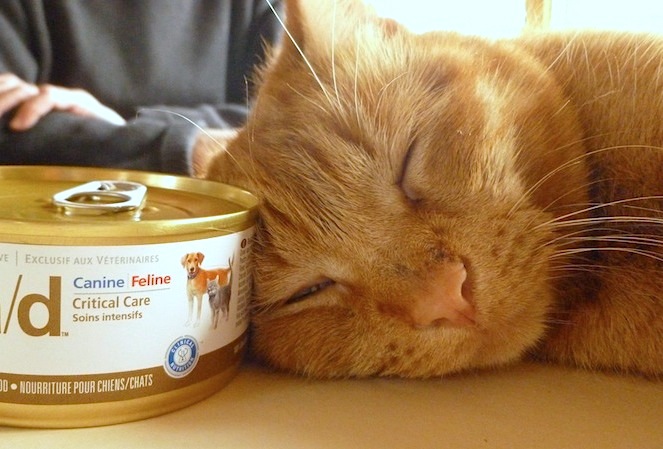[ad_1]

This pet health content was written by a veterinarian, Dr. Debora Lichtenberg, VMD. It was reviewed for accuracy by Dr. Pippa Elliott, BVMS, MRCVS, and was last updated Feb. 4, 2019.


Petful may earn a commission if you click on our links and make a purchase. This comes at no extra cost to you and helps us continue providing trusted pet product reviews.
We were watching television in the dark when our new orange kitty, Button Boy, jumped onto my husband’s lap.
“He’s too thin, Deb. We have to feed him… wait, it’s OG!”
After 17 long days, our missing cat had somehow made it home. He was skin and bones, exhausted, and starving, but he was home.
What Happened Before OG Returned
- The day he disappeared: On the only warm February day, OG ventured outside for the first time all winter and didn’t come back.
- The painful waiting: Days turned into weeks, and we began to fear he’d fallen victim to a coyote or a fisher cat
- The weather made it worse: Freezing temperatures and snow made survival seem impossible.
- The day he came back: While we were doing spring cleanup around the barn and garage, OG suddenly reappeared — weak but alive.
🐱 What I Learned After My Missing Cat Came Home
- Tail amputation is usually a medical necessity: It’s performed to treat severe injuries, infections, or tumors that can’t heal on their own.
- The procedure is done under anesthesia: Veterinarians remove the damaged portion of the tail while keeping recovery comfort and function in mind.
- Recovery requires proper care: Pain management, wound cleaning, and monitoring for infection are essential during healing.
- Most pets adapt quickly: Dogs and cats typically regain balance, comfort, and normal activity after recovery.
Don’t Guess When It Comes To Your Pet’s Care
Sign up for expert-backed reviews and safety alerts all in one place.




Don’t Guess When It Comes To Your Pet’s Care
Sign up for expert-backed reviews and safety alerts all in one place.
Missing Cat Comes Home: The Prodigal Cat Returns
I’ve been talking to OG every night, trying to draw him out slowly. He’s hesitant, a little withdrawn — PTSD, maybe. It’s difficult for him to “talk” about his ordeal, so I’m respecting his pain and privacy.
He doesn’t have much strength yet. Most days, he eats and sleeps while his friends try to help him readjust:
- Snoop keeps sniffing his tail, checking to make sure it’s really him.
- Buddy generously shares his food bowl upstairs.
- Button Boy just wants to play.
They don’t quite understand OG’s tired, quiet demeanor. The old OG will be back, I tell them, in time.
“Lost Cat”
The media often highlight a feel-good story about a cat who defies the odds and makes it home under hard-to-believe circumstances. From a Colorado cat turning up in Manhattan to a Long Island feline found three years later and another returning home after four years, these stories remind us just how determined and resilient cats can be.
Even in my own life as a veterinarian, I’ve seen several “lost cats” make unbelievable comebacks:
- Bluey: This 10-year-old Siamese mix came running across a field one sunny day after being missing for four months – and was somehow fatter than when she left. Apparently, she had been dining at a neighbor’s endless Fancy Feast buffet. When they moved to Texas, Bluey decided she preferred being a Yankee and came home.
- Dickens: A purebred Himalayan given to me by a client whose mother disliked him. After three years in my home, Dickens disappeared and resurfaced at a nearby posh subdivision. My lost-cat ad caught the eye of the family he had been freeloading from. They had bought him a cat condo, a covered litter box, and a water fountain. On the ride home, I told him to suck it up and appreciate free health care for life.
- Edgar: This unfortunate stray arrived at my clinic with a badly broken front leg. I repaired it, and years later, he left home after a scuffle with another cat. A year later, a woman brought in her cat for a checkup and asked about the metal in his leg – it was Edgar, now living happily under his new name, Buddy. She adored him, and he remained my patient for years.


If Your Cat Comes Back…
If a small miracle happens and your missing cat comes home after you’ve already given up hope, here’s how to help them recover safely.
Feeding
After the excitement and relief of seeing your cat again, your first instinct is to feed them, but take it slow.
- Start with small portions: Offer a small amount of canned cat food and observe how they respond.
- Avoid overfeeding: Do not let your cat eat or drink too much too quickly, as this can cause digestive upset.
- Watch for starvation effects: True starvation can cause electrolyte imbalances and liver damage that may not be immediately visible.
- Feed frequently in small amounts: Give small meals for the first 24 hours. If your cat keeps food down, gradually increase portions the next day.
- Choose the right diet: High-protein, high-fat, low-carbohydrate food is best for rebuilding strength.
Learn more about digestive recovery in vomiting and diarrhea in cats to understand how to manage post-starvation sensitivities.
Call the Vet
If your cat appears stable, there’s no need to panic, but schedule a veterinary checkup as soon as possible.
- Emergency care: If your cat is weak, dehydrated, or in visible distress, call your vet immediately.
- Diagnostics: Expect blood work and a fecal test to evaluate hydration, organ function, and nutritional status.
- Treatment support: Your vet may provide IV fluids, injectable B vitamins, or feeding guidance based on test results.
- Severe cases: Cats too weak to eat may need feeding tubes or IV support until they regain strength.
True Starvation
Most lost cats manage to find enough food and water to survive. However, the worst cases occur when a cat becomes trapped without access to either.
- Locked in sheds or garages: Many cats are accidentally sealed inside outbuildings for days or weeks.
- Pet-sitting risks: Miscommunication with a sitter can lead to neglect if feeding schedules are unclear.
- Prevent problems: Always check in within 24 hours when leaving your pet in someone else’s care to confirm all instructions are understood.
OG’s Progress
OG has been home for six days now and continues to improve. He spends most of his time resting and eating as his energy slowly returns.
- Weight recovery: Before disappearing, OG weighed 10 pounds; he came home under 7. He needs to regain about a third of his body weight.
- Current condition: His only lingering issue is mild diarrhea, which is improving.
- Diet plan: With his liver and kidneys functioning normally, he is now on a high-protein, high-fat, calorie-dense diet split into eight small feedings each day.
Turned Inside Out!
OG would never have faced this ordeal if he had stayed indoors. Letting cats outside exposes them to predators, vehicles, and other dangers.
- Indoor life is safer: While watching country cats explore is enjoyable, outdoor risks far outweigh the benefits.
- Lesson learned: OG is now safe at home, curled up by the fire, and his cat door may remain locked for good.
- A happy ending: He is slowly rebuilding his strength, and as I look at him, I can almost hear him think, “There’s no place like home.”
Recommended Recovery Supplies for Cats
Helping your cat recover after being lost takes patience and the right essentials. These products can make the transition home smoother and safer:
- Nutrient-rich wet food: Soft, high-protein formulas are gentle on the stomach and help rebuild strength.
- Hydration boosters: Pet-safe electrolyte solutions or broth toppers support hydration after days without water.
- Pet insurance: A plan from MetLife Pet Insurance can help cover post-recovery vet visits and unexpected medical costs.
- Microchip and ID tags: If your cat isn’t microchipped, now’s the time it’s the best safeguard against future disappearances.
Learn more about these trusted options in our editorial spotlights on MetLife Pet Insurance.
Final Thoughts
When a missing cat comes home, it feels nothing short of miraculous. The relief, the tears, and the renewed sense of connection remind us just how strong the bond is between people and their pets.
Take it slow, offer gentle care, and let your cat regain strength at their own pace. Most importantly, learn from the experience microchip your cat, keep ID tags updated, and secure doors or windows to prevent another disappearance.
For now, OG is home, safe, and healing. His story is proof that even after weeks of worry, love and persistence can bring our furry family members back where they belong.
Frequently Asked Questions (FAQ)
Do missing cats usually come back?
Yes, many missing cats return home on their own, especially indoor-outdoor cats that hide nearby until they feel safe.
What is the 3-3-3 rule for cats?
The 3-3-3 rule means it takes about 3 days for a cat to decompress, 3 weeks to adjust to a new routine, and 3 months to feel fully settled.
How long does it take for a missing cat to come home?
Some cats return within a few days, while others may take weeks or even months to find their way back.
How long before you should worry about a missing cat?
You should start searching immediately if your cat goes missing, as early action greatly increases the chances of finding them safely.
[ad_2]